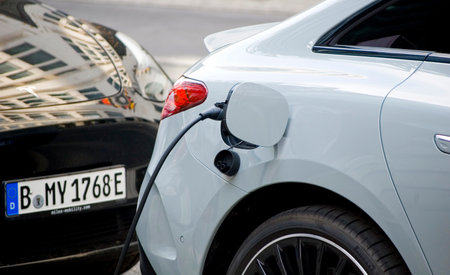1. Introduction to AI in Electric and Autonomous Vehicles
Artificial intelligence (AI) is playing a crucial role in the advancement of electric and autonomous vehicles. As technology continues to evolve, AI is being integrated into various aspects of vehicle design, functionality, and infrastructure. It enhances efficiency, improves safety, and enables automation in ways that were once considered futuristic.
How AI Powers Electric and Autonomous Vehicles
AI helps optimize many aspects of both electric and self-driving vehicles. From energy management in electric cars to real-time decision-making in autonomous vehicles, AI-driven systems are revolutionizing the driving experience.
AI Applications in Vehicle Development
| Application | Function |
|---|---|
| Battery Management | Optimizes charging, usage, and longevity of EV batteries |
| Autonomous Driving | Processes sensor data to make real-time driving decisions |
| Driver Assistance | Enhances safety through lane-keeping, adaptive cruise control, and collision avoidance |
| Predictive Maintenance | Uses AI to detect potential issues before breakdowns occur |
| Traffic & Navigation | Improves route planning and reduces congestion through AI-based traffic analysis |
Why AI is Essential for Vehicle Integration
AI allows electric and autonomous vehicles to work together seamlessly, transforming the way we drive and maintain vehicles. For electric vehicles (EVs), AI ensures efficient energy consumption and smart charging. In autonomous vehicles, AI enables advanced perception, decision-making, and vehicle control to safely navigate roads.
Key Benefits of AI in Vehicle Integration
- Enhanced vehicle safety through real-time decision-making
- Improved battery efficiency for extended EV range
- Optimized navigation and traffic management
- Reduced vehicle downtime with predictive maintenance
- Greater driving comfort with AI-powered assistance
Looking Ahead
The role of AI in electric and autonomous vehicle integration is growing rapidly. As AI technology continues to evolve, its applications in vehicle automation and energy efficiency will become even more advanced, paving the way for a smarter and safer future of transportation.
2. Enhancing Vehicle Autonomy with AI
Artificial intelligence (AI) plays a crucial role in enabling self-driving capabilities in electric and autonomous vehicles. From perceiving the environment to making real-time driving decisions, AI-powered systems transform how vehicles operate without human intervention.
AI-Powered Perception Systems
For a vehicle to drive autonomously, it must accurately perceive its surroundings. AI enhances vehicle perception through advanced sensor fusion, combining data from:
- LiDAR: Uses laser pulses to map the environment in 3D.
- Radar: Detects objects at various distances, even in poor weather conditions.
- Cameras: Recognizes traffic signs, lane markings, and obstacles.
- Ultrasonic Sensors: Helps with close-range detection, such as parking assistance.
AI-Driven Decision-Making
Once the vehicle gathers data, AI algorithms process and analyze the information to make safe driving decisions. These include:
| Decision-Making Aspect | AI Role |
|---|---|
| Object Recognition | Identifies pedestrians, vehicles, cyclists, and road signs. |
| Path Planning | Calculates the safest and most efficient driving path. |
| Collision Avoidance | Predicts potential collisions and adjusts speed or direction. |
| Traffic Adaptation | Adjusts driving behavior based on traffic flow and signals. |
Real-Time Navigation and Adaptation
AI-driven navigation ensures the vehicle adapts to changing road conditions. Machine learning models analyze live map data, traffic conditions, and weather updates to guide the vehicle smoothly. With continuous learning, AI improves driving performance over time, providing a safer and more efficient driving experience.

3. AI in Battery Management and Energy Optimization
Artificial intelligence plays a crucial role in enhancing battery management and optimizing energy consumption in electric vehicles (EVs). By leveraging machine learning algorithms and real-time data analysis, AI helps maximize battery efficiency, extend battery life, and improve overall energy utilization.
Battery Efficiency Enhancement
AI-powered systems monitor battery usage patterns and environmental conditions to optimize energy distribution. These systems analyze factors like driving behavior, temperature, and charging habits to adjust power output and reduce degradation. This results in extended battery lifespan and better performance over time.
Charging Optimization
One of the biggest concerns for EV owners is efficient charging. AI enables smart charging strategies by determining the best times to charge based on power grid demand, electricity costs, and battery condition. Additionally, AI can predict charging needs and suggest ideal charging stations along the route to minimize wait times and enhance convenience.
AIs Role in Smart Charging
| Feature | Function |
|---|---|
| Load Balancing | Distributes power efficiently across multiple charging stations |
| Dynamic Pricing | Optimizes charging cost based on electricity rates |
| Predictive Maintenance | Detects battery issues before they lead to failures |
| Grid Integration | Helps balance energy demand and supply with smart grid systems |
Overall Energy Management
AI assists in making EVs more energy-efficient by managing power distribution between different components, such as climate control, lighting, and propulsion systems. It can also integrate with regenerative braking systems to recover energy during deceleration and feed it back into the battery, reducing overall energy waste.
AI-Powered Energy Optimization Techniques
- Predictive Analytics: AI anticipates energy requirements based on driving conditions and adjusts power usage proactively.
- Regenerative Energy Usage: Captures and reuses kinetic energy to improve overall efficiency.
- Adaptive Energy Allocation: Dynamically adjusts power distribution to key vehicle systems for optimal performance.
By leveraging AI, EVs can achieve greater energy efficiency, reduced charging times, and prolonged battery life, making them more practical and cost-effective for everyday use.
4. AI for Safety, Driving Assistance, and Predictive Maintenance
Artificial intelligence is playing a key role in improving vehicle safety, enhancing driving assistance systems, and making predictive maintenance more effective. As electric and autonomous vehicles become more mainstream, AI-driven technologies help ensure a safer and more reliable driving experience.
AI-Driven Safety Features
AI enhances vehicle safety by detecting potential hazards and assisting drivers in avoiding accidents. Smart sensors, cameras, and radar systems analyze real-time data to identify dangers on the road. Some of the most common AI-powered safety features include:
- Automatic Emergency Braking (AEB) – AI detects imminent collisions and applies brakes automatically.
- Lane Departure Warning (LDW) – Warns the driver if the vehicle unintentionally drifts out of its lane.
- Blind Spot Detection – Monitors blind spots and alerts the driver of nearby vehicles.
- Pedestrian Detection – Recognizes pedestrians and prompts the driver or applies brakes if necessary.
AI-Powered Driver Assistance Systems
Advanced Driver Assistance Systems (ADAS) use AI to make driving easier and less stressful. These systems help drivers maintain better control over their vehicles through automation and real-time decision-making. Below are some key driver assistance features:
| AI Feature | Function |
|---|---|
| Adaptive Cruise Control | Automatically adjusts vehicle speed based on traffic conditions. |
| Traffic Sign Recognition | Reads traffic signs and alerts the driver to speed limits and warnings. |
| Parking Assistance | Uses cameras and sensors to help with parallel and perpendicular parking. |
| Driver Monitoring Systems | Detects driver fatigue or distraction and issues alerts. |
AI in Predictive Maintenance
AI helps with predictive maintenance by analyzing vehicle performance data to identify potential issues before they become serious problems. This reduces unexpected breakdowns and ensures the longevity of the vehicle.
How Predictive Maintenance Works
- Sensor Data Analysis – AI collects data from sensors monitoring engine health, battery performance, and other critical components.
- Machine Learning Models – AI predicts part failures based on historical data and usage patterns.
- Real-Time Alerts – Drivers and fleet managers receive notifications about potential maintenance needs.
By integrating AI into vehicle safety, driver assistance, and predictive maintenance, electric and autonomous vehicles are becoming more reliable, efficient, and safer for drivers and passengers alike.
5. Five, The Future of AI in Mobility and Smart Transportation
As artificial intelligence (AI) continues to evolve, its role in electric and autonomous vehicle integration is set to expand significantly. Future advancements in AI technology will enhance smart transportation ecosystems, improve vehicle performance, and revolutionize mobility solutions. Below, we explore some of the most promising developments in this field.
AI-Powered Enhancements in Electric and Autonomous Vehicles
AI is reshaping the way electric and autonomous vehicles operate by optimizing efficiency, safety, and user experience. Here are some key advancements expected in the near future:
| AI Advancement | Impact on Electric and Autonomous Vehicles |
|---|---|
| Advanced Machine Learning Algorithms | Improve decision-making capabilities for safer navigation and efficient energy management. |
| Real-Time Data Processing | Enhance situational awareness by analyzing data from cameras, sensors, and traffic systems instantly. |
| Predictive Maintenance | Reduce vehicle downtime and costs by identifying potential issues before they cause failures. |
| Enhanced Vehicle-to-Everything (V2X) Communication | Allow seamless interactions between vehicles, infrastructure, and pedestrians for increased safety. |
Transforming Smart Transportation Ecosystems
AI is also playing a key role in developing smart transportation systems beyond individual vehicles. Cities and organizations are leveraging AI-driven solutions to enhance public transportation, optimize traffic flow, and reduce congestion. Some notable advancements include:
- AI-Based Traffic Management: Adaptive traffic lights and AI-driven routing systems can dynamically adjust traffic patterns to reduce delays.
- Autonomous Public Transit: AI-powered buses and trains equipped with real-time monitoring systems can enhance reliability and efficiency.
- Shared Mobility Solutions: AI-assisted ride-sharing platforms can improve fleet management and minimize emissions.
Future Mobility Solutions with AI
Innovations in AI will shape the next generation of mobility solutions, making transportation smarter, safer, and more accessible. Here are some exciting possibilities:
Hyper-Personalized Autonomous Rides
AI-driven personalization will allow autonomous vehicles to adapt to user preferences, optimizing comfort and convenience during travel.
AI-Optimized EV Charging Networks
Smart charging stations powered by AI will predict demand, optimize energy distribution, and reduce wait times for electric vehicle (EV) users.
Autonomous Freight and Logistics
AI will enable self-driving trucks and drones to deliver goods efficiently, reducing transportation costs and enhancing supply chain management.
With continuous AI advancements, the future of electric and autonomous vehicles, along with smart transportation systems, looks increasingly promising. The integration of AI into mobility solutions will not only improve efficiency but also enhance overall sustainability and convenience.


